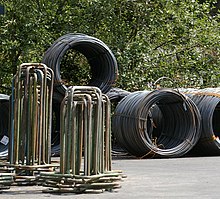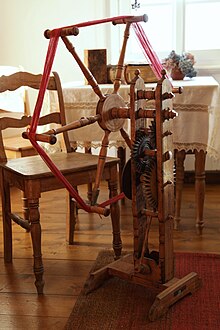reel
The reel , often called weife , is a technical aid for winding and unwinding elongated materials such as yarn , ropes , wires and tapes.
Reels consist of a roller, spool or cross-shaped structure that is rotatably mounted around a central axis with a crank . A reel is used for the purpose of bringing the above materials into a manageable, compact form, to secure them from tangling and knotting, to measure the wound length of the material using gears and to store them in this form until further use . There are also devices whose names are derived from the shape of the reel, but which have a different function.
Textile technology
Rotary reels

In the spinning mill , the reel is used to bring yarn into the form of a strand that can be further processed by washing, bleaching , dyeing or is traded in this form. Rotary reels have at least four arms, but there are also five- to eight-armed examples, and reels with six arms are very common. They can stand free or screwed to a table. Each reel has an auxiliary device for turning: a turning knob, a crank, which is attached near the axis. It is unwound from a supply of yarn, which is usually present on a bobbin and can run off without counter- tension . The reel is set in circular, vertical movement and the thread is guided over the crossbars on the reel arms.
Many reels also have a counter, which is usually driven by wooden gears . The circumference of a reel and thus the length of the strand has been precisely defined by regional regulations since the 17th century and had to be verified by calibration .
The following regionally based scopes are documented:
- Hunsrück: 1.90 meters
- Hessen: 2.19 meters or 4 cubits
- Linen yarn in Lippe as a "long reel": 2.02 meters
- Wool in Lippe as a "short reel": 1.30 meters
With the counter, which measures the number of revolutions, and the specified circumference, a precisely defined length of yarn could be reeled and put on the market. It is also possible to determine the weight per length, the count of the yarn . By falling below the reel circumference or the number of revolutions, the yarn price could be cheated, which is why compliance with the regulations was strictly controlled by the authorities. In the county of Ravensberg alone in the years 1712, 1743, 1744, 1762, 1765, 1777 and 1803, edicts against the “fraudulent use of yarn” were issued again and again.
- Counting mechanisms
- Watch reel : The gear drive moves a pointer on a dial, showing the number of revolutions.
- Knocking reel : When the prescribed number of revolutions is reached, a wooden hammer falls on a plate and gives an acoustic signal to stop. The hammer is lifted by a split pin on the gear drive.
- Click reel or faster : A narrow strip (leaf spring) made of wood or metal is lifted by a split pin on the gear drive. When the prescribed number of revolutions is reached, this "tongue" flicks back and generates a rasping warning sound.
These mechanisms can be combined, for example as a knocking reel with an additional dial.
- Yarn reels
Garnhaspeln serve neither the store nor the Ab wrap of threads. The strand is drawn off directly after reeling. In order to prevent threads from slipping off the ends of the spars during the reeling process, these transverse spars are usually secured by side elevations. Various constructions are common so that the live strand can be released without damage
- The side elevation is missing on a cross bar (compare the illustration of a cross reel).
- A reel arm can be folded down after loosening a cotter pin.
- A spar can be rotated so that the elevation slides away from under the yarn. This reel arm, which is structurally different from the others, is called the stranger .
- Twine winches
The drawn-off strand has a somewhat reduced circumference because the yarn wound under tension contracts to a greater or lesser extent when it is drawn off. A yarn winch is therefore required to process a strand further, for example by winding it up . Twine winches look very much like reels at first glance, differ from them in the following features:
- no device for the hand to rotate
- variably adjustable scope
- never a counter
Cross reel
The cross reel or the nicker is an aid that is structurally completely different from the rotary reel and serves the same purpose. It consists of a round wood as a handle, at the end of which a cross bar is attached. These two crossbars stand cross-shaped one above the other. The thread is placed by hand over the ends of the spars, with the cross reel making a swaying (“nodding”) movement. The non-mechanical cross reel is likely to be much older than the rotary reel.
Roller, drum and spool-shaped reels

- In the steel industry , they are used to wind up rolled steel strips or steel wire into a coil and for unwinding for further processing ( decoiler ). The coiling temperature (usually around 600 ° C) when winding hot-rolled steel strip has a major influence on the mechanical properties .
- In kites, the name for a reel on which the kite line is wound.
- In the fire brigade the hose reel , a spool-shaped aid for the quick laying and later rewinding of hoses . There are also hose reels for garden hoses, which serve the same purpose.
- Cable drums for electrical extension cables.
With these reel shapes, the demarcation to the coil is already fluid.
Word usage
Since the 18th century, the term tangled up has been used when a person makes mistakes or makes mistakes in their work. According to one theory, this use of the word comes from the damage that occurs when a spar is skipped within one revolution during reeling, and so a single piece of thread within a strand is shorter than the rest; this strand is unusable. Another theory says that the term comes from mining, where the reel worker was told by acoustic signals how to operate the reel. So it could happen that he misunderstood something and "got tangled up". Solid metal wire tends to jump off the reel in loops when it is unrolled, with the risk of creating a tangled wire that is difficult to handle.
See also
literature
- Wilhelm Hansen: Housekeeping and daily work in the old Lippe. Rural life in pre-industrial times (= writings of the Folklore Commission for Westphalia . Vol. 27). 3. Edition. Aschendorff, Münster 1987, ISBN 3-402-05665-8 .
- Hinrich Siuts : Rural and handicraft tools in Westphalia. The old tools of agriculture and rural crafts. 1890–1930 (= writings of the folklore commission for Westphalia. Vol. 26). 3rd, edited edition. Aschendorff, Münster 2002 ISBN 3-402-04126-X .
Web links
- Medieval reel (reconstruction of a cross reel for textile processing in the Middle Ages)
Individual evidence
- ↑ Also used masculine: The reel.
- ↑ Gaby Fischer: "... we want to spin it and weave it finely!" Old flax, hacked through again. Factual and unobjective around the linen shirt (= series of publications of the Rhein-Hunsrück district. Vol. 5, ZDB -ID 2238770-5 ). Self-published, Simmern 1988, pp. 154–156.
- ^ Heinz Potthoff : The Ravensberg linen trade in the 17th and 18th centuries. In: Eduard Schoneweg: The linen trade in the county of Ravensberg. A contribution to Low German folklore and antiquity. Gundlach, Bielefeld 1923. 2nd edition (reprint of the 1923 edition) Wenner, Osnabrück 1985, p. 272 (greatly expanded version of the dissertation from the University of Münster, 1911).




